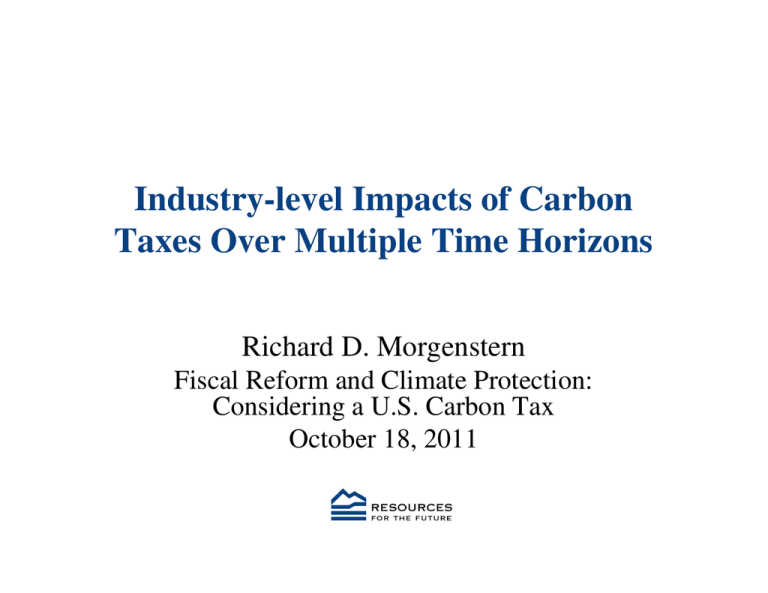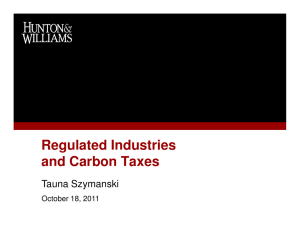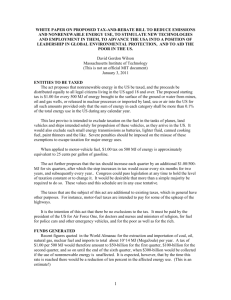Industry-level Impacts of Carbon Taxes Over Multiple Time Horizons Richard D. Morgenstern
advertisement

Industry-level Impacts of Carbon Taxes Over Multiple Time Horizons Richard D. Morgenstern Fiscal Reform and Climate Protection: Considering a U.S. Carbon Tax October 18, 2011 Competitiveness and carbon taxes • Carbon pricing will increase costs, affecting industry output, employment, and profits • Likely result in emissions leakage as well • BTU tax (1993), loosely tied to energy intensive trade exposed (EITE) metrics, exempted entire industries • Recent carbon tax literature not focused on competitiveness ; in contrast, cap and trade analyses emphasize need to incentivize carbon efficiency and maintaining output • H.R. 2454 (2009) adopts output based rebates for EITE industries plus petroleum refining Methods for estimating policy impacts • ‘bottom-up’ models contain technology detail for narrowly defined industries, but do not explain prices/quantities as part of whole economy • ‘top-down’ CGE models cover the whole economy, or even the world, and determine prices and quantities endogenously, but often do not have detailed industries. • Short-run and long-run effects often not clearly distinguished. Recent Modeling Studies Fischer and Fox (2007, 2009), and U.S. Interagency Report (2009) focus on long run CGE analysis Adkins et. al. (2010) examine four time horizons: • Very Short Run: All input quantities fixed, output price fixed. • Short Run: Higher prices reduce sales and output but no input substitution • Medium Term: CGE analysis; input substitution allowed but industry capital fixed • Long run : GGE Analysis; reallocation of capital allowed Identification of Hardest Hit Industries • Readily identifiable set of industries at greatest risk of output losses: Petroleum refining Chemicals and plastics Ferrous metals Nonferrous metals Nonmetallic mineral products • Impacts vary over different timeframes 10% Coal Mining Other Mining Activities Electric Utilities (inc govt enterprises) Gas Utilities Construction Trade Air Transportation Truck Transportation Other Transportation Information Finance and Insurance Real Estate and Rental Business Services Other Services Govt exc. Electricity Miscellaneous Manufacturing Farms Forestry, Fishing, etc Oil Mining Gas Mining Machinery Computer & Electrical Equipment Motor Vehicles Other Transportation Equipment Alumina Refining, Primary & Secondary Aluminum Ferrous Metal Foundries Non-Ferrous Metal Foundries Other Primary Metals Fabricated Metals Plastics and Material Resins Artificial & Synthetic Fibers, Filaments Fertilizers Other Chemical & Plastics Glass Containers Cement Lime and Gypsum Mineral Wool Other Nonmetallic Mineral Iron and Steel Mills and Ferroalloy Pulp Mills Paper Mills Paperboard Mills Other Papers Refining-LPG Refining-Other Petrochemical Manufacturing Basic Inorganic Chemical Mfg Other Basic Organic Chemical Mfg Food Textile Apparel Wood & Furniture Change in Profits Ability to Raise Prices Key to Maintaining Profitability -90% -80% -70% -60% -50% -40% -30% -20% Very-short-run (fixed output) -10% Short-Run 0% Adverse Impacts Concentrated in Narrowly Defined Industries • Greatest harm concentrated in segments of three digit manufacturing industries (NAICS): Other basic chemicals Aluminum Petrochemicals Artificial fibers Plastics and resins • Some industries, mostly nonmanufacturing, gain slightly as expenditures switch away from carbon intensive sectors Impacts on Output Vary Over Time ($15/Ton Tax, no Rebates) -1.2 % Change in Output -1 -0.8 -0.6 Short-Run Medium-Run Long-Run -0.4 -0.2 0 Average for all EITE Industries (including Petroleum) Impact on Output for key EITE Industries ($15/Ton Tax, without Rebates) -3.50 -3.00 % Change in Output -2.50 -2.00 -1.50 Short-Run No Rebates Medium-Run No Rebates Long-Run No Rebates -1.00 -0.50 0.00 0.50 Food, Textiles Beverages, and Tobacco Wood Ferrous MetalsNonferrous Paper and Petroleum and Chemicals, Non-Metallic primary metals Publishing Coal ProductsRubber, and Mineral Plastics Products Output Based Rebates for H.R. 2454 8.3 3.1 0.0 15.9 405.2 Subsidy rate (% of output) 0.001% 0.005% 0.010% 0.157% Qualifying share of output (%) 1.4% 1.6% 0.0% 4.1% 21.5% 32.0 0.771% 100.0% Amount (mil $) Food, Beverages, and Tobacco Textiles Wearing Apparel and Leather Wood Paper and Publishing - Pulp mills - Paper mills Petroleum and Coal Products - Refining-lpg - Refining-other Chemicals, Rubber, and Plastics - Petrochemical manufacturing - Basic Inorganic Chemical Mfg - Other Basic Organic Chemical Mfg - Artificial and Synthetic Fibers and Filaments - Fertilizers - Other Chemical & Plastics Non-Metallic Mineral Products - Glass containers - Cement - Lime and Gypsum - Mineral Wool - Other Nonmetallic Mineral Ferrous Metals - Iron and Steel Mills and Ferroalloy Nonferrous primary metals - Alumina Refining, etc. - Other Primary Metals Electric Utilities Gas manuf. and distribution 373.2 0.727% 100.0% 2,019.9 0.422% 100.0% 114.1 0.422% 100.0% 1,905.8 0.422% 100.0% 1,765.3 0.241% 30.7% 644.8 1.226% 100.0% 150.0 0.584% 100.0% 763.2 1.022% 100.0% 67.7 0.796% 100.0% 62.8 0.568% 32.4% 76.7 0.016% 12.4% 584.8 0.489% 33.2% 29.8 0.678% 100.0% 451.5 4.381% 100.0% 35.4 0.396% 18.5% 26.5 0.412% 100.0% 41.6 0.046% 18.9% 905.4 0.876% 80.6% 905.4 1.087% 100.0% 151.3 0.185% 39.5% 135.5 0.591% 100.0% 15.8 0.034% 20.3% 26,933.0 8,079.8 7.234% 7.005% - Output Based Rebates Quite Effective in Mitigating Adverse Impacts -1.2 % Change in Output -1 -0.8 -0.6 without Rebates with Rebates -0.4 -0.2 0 SR MR LR Average for all EITE Industries Plus Petroleum Impact on Output for EITE Industries Plus Petroleum ($15/Ton Tax, with and without Rebates) -3.50 -3.00 -2.50 % Change in Output -2.00 -1.50 Short-Run No Rebates Short-Run Rebates -1.00 Medium-Run No Rebates Medium-Run Rebates -0.50 Long-Run No Rebates Long-Run Rebates 0.00 0.50 1.00 1.50 Food, Textiles Beverages, and Tobacco Wood Ferrous MetalsNonferrous Paper and Petroleum and Chemicals, Non-Metallic primary metals Publishing Coal ProductsRubber, and Mineral Products Plastics International Trade • While changes in output resulting from domestic carbon pricing reflect changes in U.S. industrial activity, they do not necessarily reflect changes in consumption • To understand impacts on consumption, one needs to consider changes in exports and imports Trade Impacts of $15/ton CO2 price (% changes) 14 Trade Impacts of $15/ton CO2 price (% changes) 15 Emissions Leakage, Multilateral Action • Emissions leakage arises from trade effects and fuel price driven emission intensity changes in non-policy nations • Fischer and Fox, and Adkins et al. find the latter to be larger than the former • In sensitivity analysis, we calculate the importance of multilateral action: with only unilateral carbon pricing, EITE output losses almost twice those reported here Output Based Rebates in a Carbon Tax Regime • Output based rebates incentivize (downstream) output while maintaining carbon efficiency incentives created by carbon pricing (upstream) • Despite economic costs, clear political economy gains of the rebates • To mimic the incentives of output based rebates in an (upstream) carbon tax regime, downstream refundable tax credits needed for EITE industries • Design of such tax credits probably straightforward, except for risk of overcompensation in the case of unexpected innovation that reduces mitigation costs Conclusions • Competitiveness impacts of carbon pricing non trivial • Fortunately, studies from cap and trade literature have considered impacts and potential remedies • Field is quite open to better targeting rebates • Carbon tax analyses need to build on such studies and incorporate/expand policy approaches Thank you




